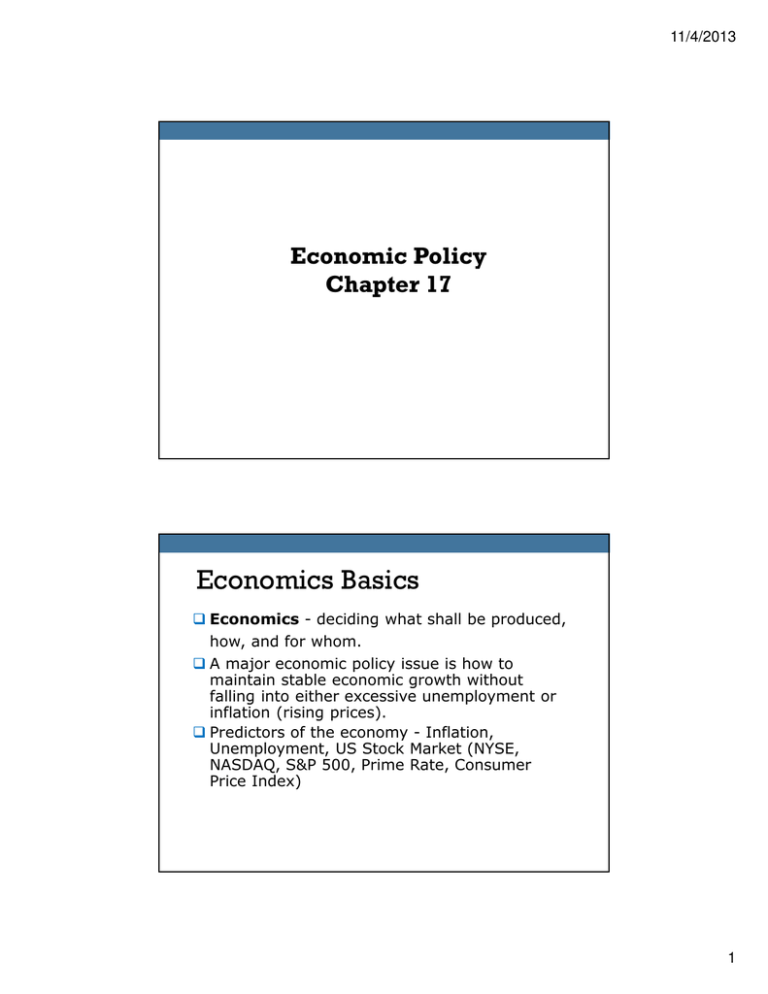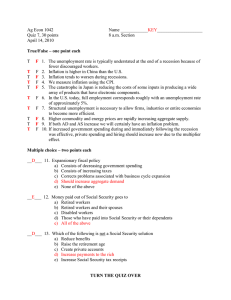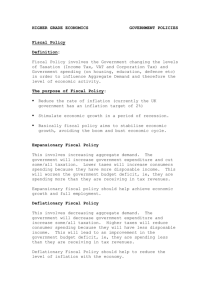Economics Basics Economic Policy Chapter 17
advertisement

11/4/2013 Economic Policy Chapter 17 Economics Basics Economics - deciding what shall be produced, how, and for whom. A major economic policy issue is how to maintain stable economic growth without falling into either excessive unemployment or inflation (rising prices). Predictors of the economy - Inflation, Unemployment, US Stock Market (NYSE, NASDAQ, S&P 500, Prime Rate, Consumer Price Index) 1 11/4/2013 Measuring the Performance of the Economy Economic Growth – measured by Gross domestic product (GDP) which is a widely used measure of the performance of the economy; GDP is a nation’s total production of goods and services for a single year valued in terms of market prices. Unemployment - percentage of the civilian labor force who are looking for work or waiting to return to or begin a job. Full employment, an arbitrary level of unemployment that corresponds to “normal” friction in the labor market. Measuring Unemployment. (3-5% considered good) Inflation - sustained rise in the general price level of goods and services erodes the value on fixed incomes. Consumer Price Index (CPI), an inflationary indicator that measures the change in the cost of a fixed basket of products and services, including housing, electricity, food, and transportation. The CPI is published monthly. also called cost-of-living index Measuring the Performance of the Economy Recession—Economists define a recession as two or more quarters of negative economic growth (shrinking), that is, declines in the gross domestic product. Depression, a sustained, long-term downturn in economic activity in one or more economies. It is a more severe downturn than a recession, which is seen as part of a normal business cycle. Economic Stability - A situation in which there is economic growth, rising national income, low unemployment, and steadiness in the general level of prices The U.S. economy experiences booms and busts. The busts are called recessions. Bear vs Bull Market 2 11/4/2013 Nineteenth Century Laissez-faire “To leave alone” economic philosophy Industrialization Increased accidents and disease Disrupted the natural business cycles Interstate Commerce Act (1887) Intended to rein in the railroads Sherman Anti-Trust Act (1890) Prohibited restraints of trade Progressive Era Drew support from the middle class Sought to reform political, economic and social systems Pure Food and Drug Act; Meat Inspection Act (1906) Beginning of consumer protections Banking and business regulation Federal Reserve Act (1913) Sixteenth Amendment Collection of federal income taxes 3 11/4/2013 Great Depression and the New Deal Financial reforms Glass-Steagall Act; created Federal Deposit Insurance Corporation (FDIC) Securities Act; Securities Exchange Act – required prospective investors to be accurately informed before investing Agricultural Adjustment Act (AAA) Granted subsidies to farmers National Labor Relations Act (Wagner Act) Guaranteed workers’ right to unionize Industry Regulations Expanded regulations for communications, civil aviation, trucking industries Deregulation Definition: Reduction in market controls in favor of market-based competition Airline Deregulation Act of 1978 Eliminated economic regulation of airlines Ultimately resulted in less competition Agriculture Congress reduced, then replaced, subsidies Financial Sector Deregulation in the 1990s helped lead to subprime mortgage crisis 4 11/4/2013 How Do Agriculture Subsidies Regulate the Economy? Fiscal Policy Foundations of Fiscal Policy British economist John Maynard Keynes Argued that government could avoid recession by stimulating demand, even if it caused deficits Fiscal Policy – achieving economic goals through changes in taxing, spending or borrowing activities of the national government Revenue Act of 1964 Reduced personal and corporate income taxes Expanded the economy; led to 4% unemployment Budget Deficits Long term can lead to inflation 5 11/4/2013 Fiscal Policy continued Responding to Recession Economic Slowdown of 2008 $168 billion stimulus package $700 billion financial crisis bailout package (Emergency Economic Stabilization Act) Troubled Assets Relief Program (TARP) American Recovery and Reinvestment Act Where Did the Economic Stimulus Funds Go? 6 11/4/2013 Fiscal Policy continued The Debt Ceiling National Debt Effect of Bush Administration tax cut, wars in Iraq and Afghanistan, bailout bills National debt reached $14.2 trillion in 2011 Debt Ceiling Similar to a credit card limit Congress must vote to spend above it Budget Control Act of 2011 Authorized a series of automatic debt ceiling increases, but: Triggered automatic spending cuts in 2013 Fiscal Policy continued Fiscal Policy on a Global Context Globalization - benefits Seen in greater movement of goods, services and capital across borders Increases variety of goods to consumers, lowers costs and raises standard of living Globalization - concerns Greater risk that financial collapse in one country can spread to others Examples: Greece and Spain Increasing interdependence Measured by regional share of gross domestic product (GDP) 7 11/4/2013 How Has Economic Interdependence Altered the American Economy? Monetary Policy Monetary Policy – helps stabilize the economy by regulating the nation’s supply of money and influencing interest rates. The Federal Reserve System Structure Federal Reserve Board Federal Open Market Committee 12 Federal Reserve Banks Other member banks Board of Governors Dual Mandate Control inflation Limit unemployment 8 11/4/2013 Monetary Policy continued Tools of Monetary Policy Open market operations Buying and selling of government securities, or debt Discount rate Rate of interest at which it lends money to member banks Reserve requirements Designate the portion of deposits that member banks must retain on hand How Does the Federal Reserve System Work? 17.3 9 11/4/2013 So Is Fiscal or Monetary Policy Better The Answer is both Monetary Policy If interest rates go high enough, people will stop borrowing money and inflation will subside. Cannot force people to borrow money in a recession More power against inflation Fiscal Policy More effective against recessions because the government does the borrowing itself Another theory similar to Fiscal Policy is Supply Side Economics…higher taxes hurt everyone. For example, in a good economy, taxes should be not raised. Foundations of Income Security Policy Franklin D. Roosevelt and the New Deal Civil Works Administration (CWA) – put people to work on public works projects Works Progress Administration (WPA) – disbanded after CWA was in force. Used to put people to work on improving playgrounds, schools, hospitals, and airfields Social Security Program (1935) – provide assistance to the elderly and disabled 10 11/4/2013 Income Security Programs Today Definitions Entitlement programs - benefits that all citizens who meet eligibility requirements are entitled to receive. Examples include Social Security, Medicare, and Medicaid, most Veterans' Administration programs, federal employee and military retirement plans, unemployment compensation, food stamps, and agricultural price support programs. Non-means tested programs - provide cash assistance to qualified beneficiaries, regardless of income. Social Security is an example of a non-means-tested program Means-tested programs - require people to have incomes below a certain level to receive benefits. Food stamps are an example of this type of program. Income Security Programs Today Old Age, Survivors, and Disability Insurance - People pay into the system during their working lives, and then draw payments once they reach the minimum retirement age. Unemployment Insurance - funded through payroll taxes, pays benefits to people who have lost their jobs through no fault of their own. Supplemental Security Income - provides support to qualified people with disabilities. Supplemental Nutrition Assistance Program (SNAP) Food Stamps – must be low income and can buy most foods Women Infants and Children (WIC) – buy milk, cereal, juice and milk. Earned Income Tax Credit (EITC) – benefit for working people who have low to moderate income. It reduces the amount of tax you owe and may also give you a refund. 11 11/4/2013 Income Security Programs Today Family and Child Support – Welfare as we now know it. Formerly called Aid to Dependent Families with Children (AFDC) Personal Responsibility and Work Opportunity Reconciliation Act of 1996 revamped welfare and calls it Temporary Assistance to Needy Families (TANF) Required single mothers with a child over five years of age to work within two years of receiving funds Included a provision that unmarried mothers under the age of 18 be required to live with an adult and attend school in order to receive welfare benefits Set a five-year lifetime limit for aid from block grants Included a requirement that mothers must provide information about a child’s father in order to receive full welfare payments Cut off food stamps and SSI for legal immigrants Cut off cash welfare benefits and food stamps for convicted drug felons Limited food stamps to three months in a three year period for persons 18 to 50 years old who are not raising children and not working Estimated that 35-40 million people (11-15%) in the US have incomes below the official poverty line How Many Americans Benefit from Income Security Programs? 12 11/4/2013 Should Social Security be Privatized? The Tax Burden Individual Income Taxes - federal government’s largest source of revenue Corporate Income Taxes - set at 35% of net corporate income profits; however, corporations find many ways of reducing their taxable income, often to zero. Social Security Taxes - second largest source of federal revenue is the Social Security tax (6.2%) Medicare Taxes – 1.45% Estate and Gift Taxes - Federal estate taxes levy a tax rate that rises to 35 percent; estates worth less than $5,250,000 are exempt. The maximum exclusion for gifting is $14,000. Excise Taxes and Custom Duties - Federal excise taxes on the consumption of liquor, tobacco, gasoline, telephones, air travel, and other so-called luxury items, together with customs taxes on imports, provide about 4 percent of total federal revenues. 13 11/4/2013 How Does the Federal Government Raise and Spend Money? Tax Politics The Argument for Progressivity - Progressive taxation is generally defended on the principle of ability to pay; the assumption is that high-income groups can afford to pay a larger percentage of their incomes in taxes at no more of a sacrifice than that required of lower-income groups to devote a smaller proportion of their income to taxation. Regressive Tax – Like a Sales tax. Everyone pays the same rate. The Argument for Proportionality - Proportional (flat) taxation requires all income groups to pay the same percentage of their income in taxes. Reagan’s Reductions in Progressivity - The top marginal tax rate fell from 70 percent when President Reagan took office to 28 percent following enactment of tax reform in 1986. “Read My Lips” - Breaking his solemn pledge on taxes contributed heavily to Bush’s defeat in the 1992 presidential election. 14 11/4/2013 Tax Politics Currently, Americans pay taxes that total to somewhat less than 30 percent of the GDP. 16th Amendment (1913): income tax Federal Income Tax Rates Loopholes and Lowered Taxes Who Pays? Liberals tend to favor progressive taxes. Conservatives either favor taxes that are less progressive, or even flat or regressive. Minimum Wage - $0.25 in 1938 to now $7.25 in Texas Value of $1 is equivalent to 1900 nickel Revenue: Income Taxes 2013 tax rates Tax rate Single filers Married filing Married filing jointly or separately qualifying w idow /w idow er Head of household 10% Up to $8,925 $8,926 $36,250 $36,251 $87,850 $87,851 $183,250 $183,251 $398,350 $398,351 $400,000 $400,001 or more Up to $17,850 Up to $8,925 $17,851 $72,500 $72,501 $146,400 $146,401 $223,050 $223,051 $398,350 $398,351 $450,000 $450,001 or more $8,926$36,250 $36,251 $73,200 $73,201 $111,525 $111,526 $199,175 $199,176 $225,000 $225,001 or more Up to $12,750 $12,751 $48,600 $48,601 $125,450 $125,451 $203,150 $203,151 $398,350 $398,351 $425,000 $425,001 or more 15% 25% 28% 33% 35% 39.60% 15 11/4/2013 Tax Equity Should the wealthy be taxed at a higher rate— a progressive rate— in order to provide more services for the poor? Government Spending, Deficits, and Debt “Mandatory” Spending - Much of the growth of federal government spending over the years is attributed to mandatory spending items in the federal budget “Discretionary” Spending - Washington policymakers consider spending that is not previously mandated by law to be discretionary. Deficits - imbalances in the annual federal budget in which spending exceeds revenues. The Debt Burden - The accumulated annual federal deficits—that is, expenditures exceed revenues each year—add up to the nations national debt. Interest Burden for Future Generations - Even if the federal government manages to balance future budgets, interest payments will remain obligations of the children and grandchildren of the current generation of policymakers and taxpayers. 16







